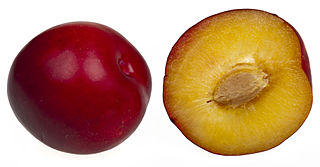
A fruit tree is a tree which bears fruit that is consumed or used by humans and some animals — all trees that are flowering plants produce fruit, which are the ripened ovaries of flowers containing one or more seeds. In horticultural usage, the term 'fruit tree' is limited to those that provide fruit for human food. Types of fruits are described and defined elsewhere, but would include "fruit" in a culinary sense, as well as some nut-bearing trees, such as walnuts.

The damson or damson plum, also archaically called the "damascene" is an edible drupaceous fruit, a subspecies of the plum tree. Varieties of insititia are found across Europe, but the name "damson" is derived from and most commonly applied to forms which are native to Great Britain. Damsons are relatively small plum-like fruit with a distinctive, somewhat astringent taste, and are widely used for culinary purposes, particularly in fruit preserves or jam.

Prunus cerasifera is a species of plum known by the common names cherry plum and myrobalan plum. It is native to Southeast Europe and Western Asia, and is naturalised in the British Isles and scattered locations in North America.

Syzygium cumini, commonly known as jambolan, Java plum, black plum or jamun, is an evergreen tropical tree in the flowering plant family Myrtaceae. It is native to the Indian Subcontinent, adjoining regions of Southeast Asia, China and Queensland. The name of the fruit is sometimes mistranslated as blackberry, which is a different fruit in an unrelated order. Syzygium cumini has been spread overseas from India by Indian emigrants and at present is common in former tropical British colonies.

Prunus salicina, commonly called the Japanese plum or Chinese plum, is a small deciduous tree native to China. It is now also grown in fruit orchards in Korea, Japan, the United States, and Australia.

The bullace is a variety of plum. It bears edible fruit similar to those of the damson, and like the damson is considered to be a strain of the insititia subspecies of Prunus domestica. Although the term has regionally been applied to several different kinds of "wild plum" found in the United Kingdom, it is usually taken to refer to varieties with a spherical shape, as opposed to the oval damsons.
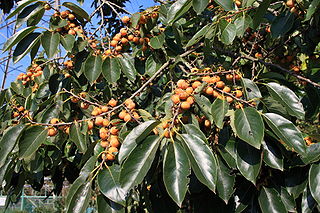
Diospyros lotus, with common names date-plum, Caucasian persimmon, or lilac persimmon, is a widely cultivated species of the genus Diospyros, native to subtropical southwest Asia and southeast Europe. Its English name derives from the small fruit, which have a taste reminiscent of both plums and dates. It is among the oldest plants in cultivation.
Terminalia ferdinandiana, also called the gubinge, billygoat plum, Kakadu plum, green plum, salty plum, murunga or mador, is a flowering plant in the family Combretaceae, native to Australia, widespread throughout the tropical woodlands from northwestern Australia to eastern Arnhem Land. It has a high concentration of vitamin C in its fruit: recorded concentrations of 2300–3150 mg/100 g wet weight and occasionally as high as 5300 mg/100 g, compared with 50 mg/100 g for oranges, ranks among the highest known of any natural source.

Spondias purpurea is a species in flowering plant in the cashew family, Anacardiaceae, that is native to tropical regions of the Americas and can be found from Mexico to Brasil. It is also very common in most of the Caribbean Islands. It is most commonly known as jocote, which derives from the Nahuatl word xocotl, meaning any kind of sour or acidic fruit. It is a popular fruit throughout Central America, particularly in Nicaragua and in Costa Rica. However, this fruit can be particularly sweet when it ripens long enough. Other common names include red mombin, plum, purple mombin, hog plum, ciruela huesito (Venezuela), ciruela, ciriguela, cirigüela, cirguela,, cirguelo (Ecuador), and siniguelas (Philippines).
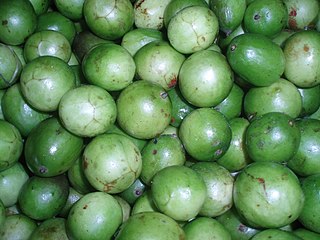
Spondias tuberosa, commonly known as imbu, Portuguese pronunciation: [ũˈbu], [ĩˈbu] Brazil plum, or umbu, is native to northeast Brazil, where it grows in the Caatinga, the chaparral scrub that grows wild across dry lands of the Sertão. The round fruit is light yellow to red in colour, around 2–4 cm in size, and has a leathery shell. The flesh is soft and juicy, with a sweet taste and distinct aroma. The fruit comes from a small tree, seldom higher than 6 m, with an expansive crown of up to 10 m in diameter. The fruit of the imbu are round and can be of varying size: they can be as small as cherries or as large as lemons. The peel is smooth and green or yellow when the fruit ripen, the small firm fruits are juicy and flavorful and their succulent flesh hides a large dark pit.

The plum curculio is a true weevil native to the regions east of the Rocky Mountains in the United States and Canada. It is notorious for destroying fruits if left uncontrolled.

Pleiogynium timoriense, commonly known as the Burdekin plum, is a medium-sized fruit-bearing tree native to Malesia, Australia and the Pacific Islands.

Davidsonia is a genus containing three rainforest tree species, that are commonly known as the Davidson or Davidson's plum. The fruits superficially resemble the European plum, but are not closely related. All species have an edible sour fruit with burgundy coloured flesh and are highly regarded as gourmet bushfood.
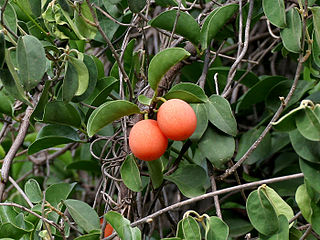
Ximenia americana, commonly known as tallow wood, hog plum, yellow plum, sea lemon, or pi'ut (Chamorro), is a small sprawling tree of woodlands native to the tropics.
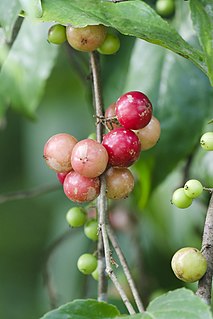
Flacourtia jangomas, Indian coffee plum, is a lowland and mountain rain forest tree in the Salicaceae or Willow Family. It is widely cultivated in Southeast and East Asia, and has escaped cultivation in a number of places. Its wild origin is unknown but is speculated to be tropical Asia, most perhaps India. This tree is very common in the Southern India and carries immense culinary and medical significance, especially in Kerala where it is commonly known as lubica or lovlolika. Fruits are eaten both raw and cooked as a jam, and the bark is sometimes used medicinally. It is sometimes harvested for its lumber. The plant is considered one of the primary host plants of the Queensland fruit fly
Parinari nonda is a shrub or small tree in the family Chrysobalanaceae. It occurs in northern Australia and New Guinea. The edible fruits are harvested in the wild. Common names include nonda plum, nonda tree, nunda plum and parinari.
Yellow plum may refer to:

Prunus hortulana, called the hortulan plum and wild goose plum, is a fruit shrub in the rose family found in the central United States in: Arkansas, Iowa, Illinois, Indiana, Kansas, Kentucky, Massachusetts, Maryland, Missouri, Nebraska, Ohio, Oklahoma, Tennessee, Texas, Virginia, West Virginia. Populations east of the Appalachians probably represent naturalizations.
